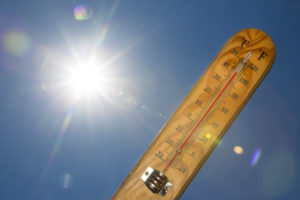This content has been archived as it may no longer be accurate or relevant.Susan Main, Speaking of Safety; 9 August 2017
We’re having a heat wave in B.C. This raises safety concerns for people working outside. Please review these tips for keeping workers safe.
It’s a hot one this summer in B.C. Not only are we dealing with wildfires, but we’re also facing record-breaking temperatures.
Last year in B.C., there were 16 claims for work-related injuries caused by heat exhaustion and heat stroke, according to a CBC news story. The occupations with the highest number of claims included: truck and bus drivers, lifeguards, recreation sport and fitness leaders, and motion-picture production assistants.
“Workers performing outdoor jobs across many industries face the risks associated with hot weather,” say WorkSafeBC’s Patrick Davie, quoted in the story. “Employers are required by law to know if their workers are at risk by performing a heat-stress assessment and implementing a mitigation plan when necessary.”
Minimizing the risk of heat stress
Working in the heat can cause heat stress, which means your body is heating up faster than it can cool itself down. This leads to serious health complications and, in extreme cases, even death. Some warning signs of heat stress include excessive sweating, dizziness, and nausea.
Here in B.C., employers are required to “provide adequate training and education to all workers at risk for heat stress, their immediate co-workers, and their supervisors,” reads Preventing Heat Stress at Work, from WorkSafeBC (available in English, Chinese, Korean, Punjabi, Spanish, and Vietnamese).
Here are some strategies employers can use to minimize risk and protect their workers:
- Have workers complete the job in a cooler environment, if possible.
- Schedule the hardest physical tasks for the coolest part of the day.
- Rotate work activities or use additional workers to reduce heat exposure.
- Ensure workers stay hydrated by drinking water before, during, and after work (remind them not to wait until they feel thirsty to drink water).
Learn more about heat stress
For more information on the signs and symptoms of heat stress, and how you can protect workers, check out these resources:
Heat stress webpage on worksafebc.com
Video – Sun Safety at Work: Workers
Video – Sun Safety at Work: Employers
You can also read some other posts I’ve written on this topic:
Video – Outdoor workers need extra protection from sun
How does sunscreen work?
Working in the hot sun
Please remember to stay safe during this heat spell – and enjoy the summer as much as you can.
Click here to see the original article
Share this Post

